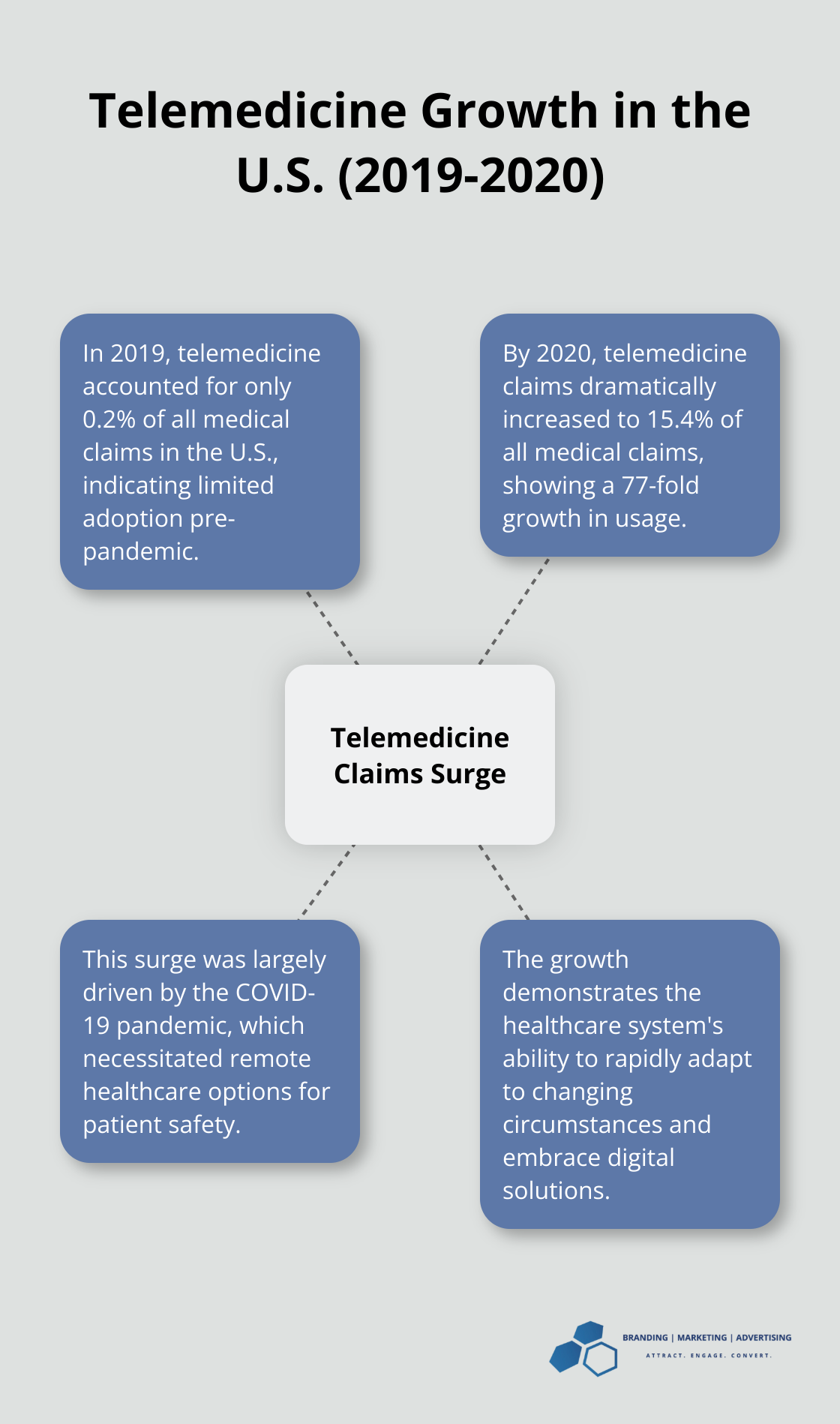Global Digital Health Market: Size and Growth Trends
At Branding | Marketing | Advertising, we’re excited to explore the rapidly expanding digital health landscape.
The global digital health market size has skyrocketed in recent years, revolutionizing healthcare delivery worldwide.
From telemedicine to AI-powered diagnostics, this sector is reshaping how we approach wellness and medical care.
In this post, we’ll examine the current state of the market, key growth drivers, and the challenges and opportunities that lie ahead.
What’s Driving the Digital Health Market?
The digital health market has transformed healthcare delivery worldwide. This sector reshapes patient care and medical practices through innovative technologies and services.
Defining Digital Health
Digital health encompasses a wide range of technologies and services that use digital tools to improve health and wellness. This includes:
- Mobile health apps
- Wearable devices
- Telemedicine platforms
- AI-powered diagnostic tools
Market Size and Growth
The numbers paint a compelling picture. The global digital health market was valued at USD 288.55 billion in 2024, and is projected to reach USD 946.04 billion by 2030, rising at a CAGR of 22.20%. This rapid growth stems from:

- Increasing smartphone adoption
- Advancements in internet connectivity
- Rising healthcare IT expenditures
Key Players Shaping the Industry
Several companies lead the charge in digital health innovation:
- Apple and Fitbit: Significant inroads with wearable devices
- Teladoc and Amwell: Explosive growth in telehealth platforms (especially since COVID-19)
- Abbott and Lunit: Cutting-edge AI solutions for personalized healthcare delivery
These innovations improve patient outcomes and create new opportunities for businesses in the healthcare sector.
Regional Market Distribution
North America will dominate the digital health landscape, accounting for 37.7% of market revenue in 2024. This leadership results from technological advancements and supportive government initiatives.
The Asia Pacific region emerges as a hotbed for digital health innovation. It will be the fastest-growing market with a projected CAGR of 14.1% from 2023 to 2032. This growth stems from the increasing adoption of eHealth platforms and mobile health solutions in countries like China and India.
Europe makes significant strides, with telemedicine contributing to 35.51% of the region’s digital health market revenue in 2022. This figure will remain strong, projected at 31.31% by 2032 with a CAGR of 10.2%.
Understanding these regional dynamics proves crucial for businesses looking to enter or expand in the digital health market. Each market presents unique opportunities and challenges (from regulatory landscapes to consumer preferences).
The digital health sector offers immense potential for growth and impact. As we explore the key drivers and trends shaping this market, it becomes clear that the future of healthcare is increasingly digital and data-driven.
What’s Fueling Digital Health’s Explosive Growth?
The digital health sector experiences unprecedented expansion, driven by several key factors that reshape the healthcare landscape. We’ve identified the primary catalysts propelling this market forward.
Telemedicine Takes Center Stage
Telemedicine has emerged as a game-changer in healthcare delivery. The COVID-19 pandemic accelerated its adoption, with telemedicine claims in the U.S. increasing from 0.2% of all medical claims in 2019 to 15.4% in 2020. This shift isn’t just a temporary trend – it reshapes how patients access care and how providers deliver it.

For businesses in the healthcare sector, this presents a significant opportunity. Investments in robust telehealth platforms and staff training to deliver high-quality virtual care can set companies apart in an increasingly competitive market. Partnerships with established telehealth providers or development of proprietary solutions will meet this growing demand.
Wearables and Health Apps Revolution
The rise of wearable technology and health apps transforms how individuals monitor and manage their health. In 2022, approximately 25% of the U.S. population used wearable devices for health monitoring. This trend creates a wealth of data and new touchpoints between consumers and healthcare providers.
For marketers and businesses, this trend opens up new avenues for customer engagement and personalized marketing. Development of apps that integrate with popular wearables or creation of content that helps users interpret their health data can position brands as valuable resources in the digital health ecosystem.
AI and Machine Learning: The New Frontier
The integration of AI and machine learning in healthcare improves diagnostics, treatment plans, and patient outcomes. The AI-driven healthcare market is projected to be valued at USD 26.6 Billion in 2024 and reach USD 187.7 billion by 2030, growing at a CAGR of 37%.
This rapid growth presents opportunities for businesses across the healthcare spectrum. From development of AI-powered diagnostic tools to creation of machine learning algorithms for personalized treatment plans, the potential for innovation is vast. Companies that invest in AI capabilities now will lead in the future of healthcare.
Personalized Medicine: Tailoring Healthcare
The shift towards personalized medicine represents perhaps the most profound trend in digital health. Leveraging genetic information, lifestyle data, and AI-driven analytics allows healthcare providers to offer truly individualized care plans. This approach not only improves patient outcomes but also increases engagement and satisfaction.
For businesses in the health sector, this trend underscores the importance of data analytics and personalized content delivery. Development of platforms that can aggregate and analyze diverse health data sources will prove crucial. Additionally, creation of marketing strategies that emphasize the benefits of personalized care can help attract and retain patients in this new era of healthcare.
Emerging Technologies Create New Market Segments
The digital health market evolves rapidly, with emerging technologies creating entirely new market segments. Virtual and augmented reality applications in medical training and therapy, blockchain for secure health data management, and 3D printing for personalized medical devices represent just a few examples of these innovative frontiers.
Companies that identify and capitalize on these emerging technologies early will position themselves as industry leaders. Investment in research and development, as well as strategic partnerships with tech innovators, will prove essential for businesses looking to stay ahead in this dynamic market.
As the digital health landscape continues to evolve, businesses must adapt quickly to capitalize on these transformative trends. The next section will explore the challenges and opportunities that lie ahead in this rapidly growing market.
Navigating Digital Health’s Evolving Landscape
The digital health sector transforms rapidly, presenting significant challenges and exciting opportunities. As we navigate this dynamic landscape, several key factors demand our attention.
Regulatory Complexities and Data Privacy
The digital health industry faces a complex regulatory environment. In the U.S., the FDA’s Digital Health Center of Excellence works to streamline the approval process for digital health technologies. However, companies must navigate a patchwork of regulations across different countries.
Data privacy remains a critical concern. The healthcare industry experienced 720 data breaches of 500 or more records in 2022 alone. To address this, companies must invest in robust cybersecurity measures and ensure compliance with regulations like HIPAA in the U.S. and GDPR in Europe.

Businesses entering the digital health space should partner with legal experts specializing in healthcare regulations. Additionally, implementing privacy-by-design principles in product development can help mitigate risks and build trust with users.
Interoperability: The Key to Seamless Care
Interoperability between different digital health systems remains a significant challenge. The lack of standardized data formats and communication protocols can hinder the seamless exchange of patient information between providers, potentially impacting care quality.
To address this, the healthcare industry moves towards adopting standards like FHIR (Fast Healthcare Interoperability Resources). Companies developing digital health solutions should prioritize compatibility with these emerging standards to ensure their products can integrate smoothly into existing healthcare ecosystems.
Bridging the Digital Divide in Healthcare
Digital health technologies have the potential to dramatically improve healthcare access in developing countries. However, limited internet connectivity and a lack of digital literacy pose challenges that must be addressed.
Innovative solutions emerge to tackle these issues. For example, offline-capable mobile health apps can provide valuable health information and basic diagnostic tools in areas with poor connectivity. Companies targeting these markets should focus on developing low-bandwidth, user-friendly solutions that can operate in resource-constrained environments.
Emerging Technologies: New Frontiers in Digital Health
The digital health landscape constantly evolves, with emerging technologies creating entirely new market segments. Virtual and augmented reality applications revolutionize medical training and therapy. Blockchain technology explores secure health data management. 3D printing opens up possibilities for personalized medical devices.
Businesses looking to stay ahead in this dynamic market must invest in research and development. Forming strategic partnerships with tech innovators can also provide a competitive edge. Companies should closely monitor trends and prepare to pivot quickly as new opportunities emerge.
Digital marketing services play a crucial role in promoting these innovative solutions and reaching target audiences effectively. As the digital health sector continues to grow, companies must adapt their marketing strategies to stay competitive and capitalize on emerging opportunities.
Website development and SEO strategies are essential for digital health companies to establish a strong online presence and attract potential customers. A well-designed website optimized for search engines can help businesses showcase their products and services effectively.
Digital marketing expertise is invaluable for companies navigating the complex landscape of digital health. From content marketing to social media strategies, a comprehensive approach can help businesses stand out in this competitive market.
SEO strategies tailored to the healthcare industry can significantly improve visibility for digital health companies, helping them reach healthcare providers, patients, and other stakeholders more effectively.
Final Thoughts
The digital health market size will expand from USD 288.55 billion in 2024 to USD 946.04 billion by 2030, with a CAGR of 22.20%. This growth stems from increased smartphone adoption, improved internet connectivity, and higher healthcare IT expenditures. Telemedicine, wearables, and AI-powered diagnostics will continue to reshape patient care, while personalized medicine and emerging technologies create new market segments.
Digital health solutions will improve care access globally, enable remote monitoring, and empower patients to manage their health actively. Companies must navigate regulatory complexities, data privacy concerns, and interoperability challenges to succeed in this dynamic market. Businesses should invest in research and development to capitalize on emerging trends and stay competitive.
Branding | Marketing | Advertising offers expertise in digital marketing, SEO, and content creation to help businesses promote their digital health solutions effectively. As the sector evolves, partnering with a knowledgeable marketing team becomes essential for standing out in this competitive landscape. The digital health revolution reshapes healthcare’s future, presenting boundless opportunities for innovative businesses.












